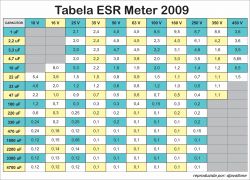ESR, or Equivalent Series Resistance, is the equivalent series resistance of a capacitor, expressed in ohms [Ω]. It turns out that a real capacitor does not behave solely as pure capacitance. In the simplest model of a real capacitor, the ESR, represented as a resistor connected in series with an ideal capacitor, must be taken into account.
The ESR results from at least the resistance of the leads and covers inside the element themselves, but the list of its constituent factors is more extensive. ESR values of electrolytic capacitors depend on:
- type of capacitor: common/low-impedance (low ESR),
- capacitance,
- maximum operating voltage,
- temperature,
- frequency,
- age,
and so on. At low temperatures, the ESR increases. The same happens as the capacitor ages.
In fact, the ESR value quoted by manufacturers is actually the impedance (measured at a certain frequency), because electrolytic capacitors are also characterised by their equivalent series inductance (ESL - Equivalent Series Inductance). It is measured in henry [H].
Defining impedance as ESR is not formally correct, but it has been accepted that way. The higher the impedance, the worse the capacitor will suppress ripple.
Example values: a typical 1000 µF/16 V capacitor from Elite (low-impedance) has an impedance of 46 mΩ at 20ºC for 100 kHz.
https://www.tme.eu/pl/details/ed1c102mnn1020/kondensatory-elektr-tht-niskoimpedan/elite/
A 10 µF/25 V capacitor from Nichicon (low-impedance) has an impedance as high as 600 mΩ at 20ºC for 100 kHz.
https://www.tme.eu/pl/details/upw1e100mdd6/kondensatory-elektr-tht-niskoimpedan/nichicon/
For common capacitors (not low-impedance), manufacturers usually quote a maximum rms value of ripple current at 120 Hz. This is related to the ESR, but converting directly to this parameter is not possible without knowing the assumptions made by the manufacturer.
The low ESR of capacitors is needed for effective ripple filtering in power supplies. Especially switching power supplies that operate at high frequencies (tens of kilohertz) need "Low ESR" capacitors. An increase in ESR above the permissible standard can result in the malfunction of such a circuit: from increased ripple levels, through 'strange' behaviour under load (switching off, interruptions) to completely unstable operation or no operation at all.
The ESR results from at least the resistance of the leads and covers inside the element themselves, but the list of its constituent factors is more extensive. ESR values of electrolytic capacitors depend on:
- type of capacitor: common/low-impedance (low ESR),
- capacitance,
- maximum operating voltage,
- temperature,
- frequency,
- age,
and so on. At low temperatures, the ESR increases. The same happens as the capacitor ages.
In fact, the ESR value quoted by manufacturers is actually the impedance (measured at a certain frequency), because electrolytic capacitors are also characterised by their equivalent series inductance (ESL - Equivalent Series Inductance). It is measured in henry [H].
Defining impedance as ESR is not formally correct, but it has been accepted that way. The higher the impedance, the worse the capacitor will suppress ripple.
Example values: a typical 1000 µF/16 V capacitor from Elite (low-impedance) has an impedance of 46 mΩ at 20ºC for 100 kHz.
https://www.tme.eu/pl/details/ed1c102mnn1020/kondensatory-elektr-tht-niskoimpedan/elite/
A 10 µF/25 V capacitor from Nichicon (low-impedance) has an impedance as high as 600 mΩ at 20ºC for 100 kHz.
https://www.tme.eu/pl/details/upw1e100mdd6/kondensatory-elektr-tht-niskoimpedan/nichicon/
For common capacitors (not low-impedance), manufacturers usually quote a maximum rms value of ripple current at 120 Hz. This is related to the ESR, but converting directly to this parameter is not possible without knowing the assumptions made by the manufacturer.
The low ESR of capacitors is needed for effective ripple filtering in power supplies. Especially switching power supplies that operate at high frequencies (tens of kilohertz) need "Low ESR" capacitors. An increase in ESR above the permissible standard can result in the malfunction of such a circuit: from increased ripple levels, through 'strange' behaviour under load (switching off, interruptions) to completely unstable operation or no operation at all.
Cool? Ranking DIY




